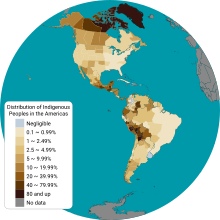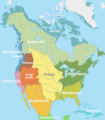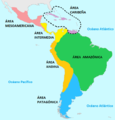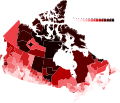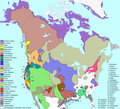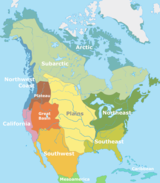Portal:Indigenous peoples of the Americas
The Indigenous peoples of the Americas PortalIn the Americas, Indigenous peoples comprise the continent's pre-Columbian inhabitants prior to European settlement in the 15th century, as well as the ethnic groups that identify with the continent's pre-Columbian population as such. These populations exhibit significant diversity; some Indigenous peoples were historically hunter-gatherers, while others practiced agriculture and aquaculture. Various Indigenous societies developed complex social structures, including pre-contact monumental architecture, organized cities, city-states, chiefdoms, states, kingdoms, republics, confederacies, and empires. These societies possessed varying levels of knowledge in fields such as engineering, architecture, mathematics, astronomy, writing, physics, medicine, agriculture, irrigation, geology, mining, metallurgy, sculpture, and goldsmithing. Indigenous peoples continue to inhabit many regions of the Americas, with significant populations in countries such as Bolivia, Canada, Chile, Colombia, Ecuador, Guatemala, Mexico, Peru, and the United States. There are at least a thousand different Indigenous languages spoken across the Americas, with 574 federally recognized tribes in the US alone. Some languages, including Quechua, Arawak, Aymara, Guaraní, Mayan, and Nahuatl, have millions of speakers and are recognized as official by governments in Bolivia, Peru, Paraguay, and Greenland. Indigenous peoples, whether residing in rural or urban areas, often maintain aspects of their cultural practices, including religion, social organization, and subsistence practices. Over time, these cultures have evolved, preserving traditional customs while adapting to modern needs. Some Indigenous groups remain relatively isolated from Western culture, with a few still considered uncontacted peoples. (Full article...) Selected article Ohlone people, also known as the Costanoan, are a Native American people of the central and northern California coast. When Spanish explorers and missionaries arrived in the late 18th century, the Ohlone inhabited the area along the coast from San Francisco Bay through Monterey Bay to the lower Salinas Valley. At that time they spoke a variety of languages, the Ohlone languages, belonging to the Costanoan sub-family of the Utian language family, which itself belongs to the proposed Penutian language phylum. The term "Ohlone" has been used in place of "Costanoan" since the 1970s by some descendant groups and by most ethnographers, historians, and writers of popular literature. In pre-colonial times, the Ohlone lived in more than 50 distinct landholding groups, and did not view themselves as a distinct group. They lived by hunting, fishing, and gathering, in the typical ethnographic California pattern. The members of these various bands interacted freely with one another as they built friendships and marriages, traded tools and other necessities, and partook in cultural practices. The Ohlone people practiced the Kuksu religion. Before the Spanish came, the northern California region was one of the most densely populated regions north of Mexico. However in the years 1769 to 1833, the Spanish missions in California had a devastating effect on Ohlone culture. The Ohlone population declined steeply during this period. Selected imageGeneral imagesThe following are images from various Indigenous peoples of the Americas-related articles on Wikipedia.
Selected biography Molly Brant (c.1736 – April 16, 1796), also known as Mary Brant, Konwatsi'tsiaienni, and Degonwadonti, was a prominent Mohawk woman in the era of the American Revolution. Living in the Province of New York, she was the consort of Sir William Johnson, the influential British Superintendent of Indian Affairs, with whom she had eight children. Joseph Brant, who became an important Mohawk leader, was her younger brother. After Johnson's death in 1774, Brant and her children returned to her native village of Canajoharie on the Mohawk River. A Loyalist during the American Revolutionary War, she fled to British Canada, where she worked as an intermediary between British officials and the Iroquois. After the war, she settled in what is now Kingston, Ontario. In recognition of her service to the Crown, the British government gave Brant a pension and compensated her for her wartime losses. Since 1994, Brant has been honored as a Person of National Historic Significance in Canada. She was long ignored or disparaged by historians of the United States, but scholarly interest in her increased in the late 20th century. She has sometimes been controversial, criticized for being pro-British at the expense of the Iroquois. A devout Anglican, she is commemorated on April 16 in the calendar of the Anglican Church of Canada and the Episcopal Church (USA). No portraits of her are known to exist; an idealized likeness is featured on a statue in Kingston and on a Canadian stamp issued in 1986. Did you know…
SubcategoriesRelated portalsThings you can do
Selected panoramaTopicsRecognized content
Featured articlesFormer featured articlesGood articles
Former good articlesDid you know? articles
In the News articlesAssociated WikimediaThe following Wikimedia Foundation sister projects provide more on this subject:
American indigenous language WikipediasAvañe'ẽ (Warani) · Aymar aru (Aymara) · ᏣᎳᎩ (Cherokee) · Chahta (Choctaw) · ᐃᔨᔫ (Cree) · ᐃᓄᒃ (Inuktitut) · Iñupiak · Kalaallisut (Greenlandic Inuit) · Mvskoke (Muscogee) · Nahuatlahtolli · Diné bizaad (Navajo) · Qhichwa Simi · Tsêhesenêstsestôtse (Cheyenne) Indigenous languages in Wikimedia Incubators: Alabama · Blackfoot · Chinook Jargon · Choctaw · Creek · Lakota · Micmac · Mohawk · Nheengatu · Northwestern Ojibwa · O'odham · Shoshoni · Unami-Lenape · Wüne pakina (Mapudungun) · Yucatec Maya · Central Alaskan Yup'ik · Zuni |

